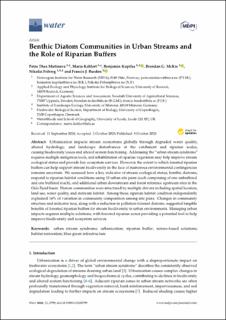| dc.description.abstract | Urbanization impacts stream ecosystems globally through degraded water quality, altered hydrology, and landscape disturbances at the catchment and riparian scales, causing biodiversity losses and altered system functioning. Addressing the “urban stream syndrome” requires multiple mitigation tools, and rehabilitation of riparian vegetation may help improve stream ecological status and provide key ecosystem services. However, the extent to which forested riparian bu↵ers can help support stream biodiversity in the face of numerous environmental contingencies remains uncertain. We assessed how a key indicator of stream ecological status, benthic diatoms, respond to riparian habitat conditions using 10 urban site pairs (each comprising of one unbuffered and one buffered reach), and additional urban downstream and forest reference upstream sites in the Oslo Fjord basin. Diatom communities were structured by multiple drivers including spatial location, land use, water quality, and instream habitat. Among these, riparian habitat condition independently explained 16% of variation in community composition among site pairs. Changes in community structure and indicator taxa, along with a reduction in pollution-tolerant diatoms, suggested tangible benefits of forested riparian buffers for stream biodiversity in urban environments. Managing urban impacts requires multiple solutions, with forested riparian zones providing a potential tool to help improve biodiversity and ecosystem services. | en_US |

